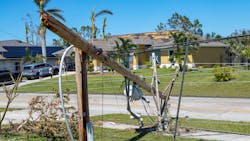FTA awards nearly $110 million in funding for natural disaster relief
The Federal Transit Administration has awarded nearly $110 million in funding to eight public transportation providers and state Departments of Transportation (DOT) in six states and one U.S. territory to help communities recover from recent natural disasters.
The funding, provided through FTA’s Public Transportation Emergency Relief (ER) Program, will help agencies repair damaged equipment and facilities and recoup costs for evacuation and rescue operations following floods, hurricanes and tornadoes that occurred in 2017 and 2020 through 2022.
“As the climate crisis accelerates, extreme weather is disrupting not just American lives and communities, but also the infrastructure we rely on every day,” said U.S. Department of Transportation (USDOT) Secretary Pete Buttigieg. “Under President Biden, USDOT is delivering much-needed funding to transit agencies to recover and rebuild after these disasters while we continue our work to combat climate change across every mode of transportation.”
“Americans cannot stop their lives because a disaster damages their transit systems,” said FTA Administrator Nuria Fernandez. “We know it is critical to fund recovery efforts for these systems so they can keep taking Americans to work, school, doctors’ appointments and other important destinations.”
The following public transportation providers and state DOTs will receive funding:
- $2.1 million to the Hillsborough Regional Transit (HART) in Hillsborough County, Fla., for providing emergency services during Hurricane Ian in 2022.
- $420,000 to the Kentucky Transportation Cabinet on behalf of the Fulton County Transit Authority to replace vehicles following a December 2021 tornado that struck Mayfield County, Ky.
- $18.6 million to the Plaquemines Port Harbor & Terminal District in the Plaquemines Parish of Louisiana to rehabilitate the Pointe à la Hache Ferry Crossing, which has been damaged by several major storms, including Tropical Storm Harvey in 2017 and Hurricane Ida in 2021.
- $75 million to the New Jersey Transit Corporation to support repairs and relocation of a 70-year-old facility damaged during Hurricane Ida in 2021.
- $201,160 to the Niagara Frontier Transportation Authority for emergency response operating costs following the December 2022 blizzard that impacted Erie and Niagara County, N.Y.
- Nearly $13.2 million to the Puerto Rico Highways and Transportation Authority to rehabilitate Tren Urbano rail system facilities and systems following Hurricanes Irma and Maria in September 2017.
- $6,769 to the Puerto Rico Highways and Transportation Authority (Arroyo) to repair a maintenance facility damaged during Hurricane Maria in 2017.
- $400,000 to the Brazos Transit District, which provides transportation services for 21 counties in central and east Texas, to repair a maintenance facility damaged in a February 2021 winter storm.
FTA says the Public Transportation ER Program not only helps states and public transportation systems repair and replace equipment and facilities that have suffered serious damage, but also provides funding to reimburse transit agencies for the costs of evacuating people during storms, rescue operations and providing temporary public transportation service. Agencies may also use the support to reestablish, expand or relocate service before, during or after an emergency.
The funding reflects a second round of grants under the Fiscal Year 2023 program. In July 2023, FTA awarded $102.3 million in funding to 17 transit agencies, cities and planning councils in eight states and territories to help recover from recent natural disasters.
The Consolidated Appropriations Act, 2023, signed into law in December 2022, provided the funding for the ER Program’s support for 2017 and 2020 through 2022 declared disasters.
